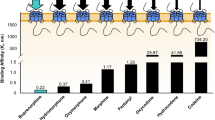Abstract
5-HT3 receptor antagonists, e.g. MDL72222, ondansetron and ICS205-930, have been previously reported to block a morphine (1.5 mg/kg)-induced conditioned place preference in rats. This finding suggests that these drugs may modify the morphine discriminative stimulus which underlies place conditioning. To study this further we have examined the effects of MDL72222, ondansetron and ICS205-930 against a morphine discriminative stimulus using a two-choice, food reinforced, operant paradigm. In an attempt to provide consistency with previous place conditioning studies, a morphine training dose of 1.5 mg/kg was used in addition to a higher 3 mg/kg dose which was studied in separate animals. Stimulus control of behaviour was attained at both morphine training doses, the characteristics of each being consistent with an effect at the mu opioid receptor. Ondansetron (0.001–1 mg/kg), MDL72222 (0.1–3 mg/kg), and ICS205-930 (0.001–1 mg/kg) all failed to consistently antagonise the morphine cue at both training doses, although a mild attenuation was seen in the 1.5 mg/kg group following pretreatment with an intermediate dose of ondansetron and ICS205-930 (both 0.01 mg/kg). The present results therefore suggest hat 5-HT3 antagonists do not block a morphine discriminative state, at least in rats.
Similar content being viewed by others
References
Bechara A, Van der Kooy D (1985) Opposite motivational effects of endogenous opioids in brain and periphery. Nature 314:533–534
Bozarth M (1987) Neuroanatomical boundaries of the reward-relevant opiate-receptor field in the ventral tegmental area as mapped by the conditioned place preference method in rats. Brain Res 414:77–84
Carboni E, Acquas E, Leone P, Di Chiara G (1989) 5-HT3 receptor antagonists block morphine- and nicotine- but not amphetamine-induced reward. Psychopharmacology 97:175–178
Colpaert FC (1977) Narcotic cue and narcotic state. Life Sci 20:1097–1108
Costall B, Naylor RJ, Tyers MB (1988) Recent advances in the neuropharmacology of 5-HT3 agonists and antagonists. Rev Neurosci 2:41–65
Extance K, Goudie AJ (1981) Inter-animal olfactory cues in operant drug discrimination procedures in rats. Psychopharmacology 73:363–371
Glennon RA, Young R, Dukat M (1992) 5-HT3 agonist 2-methylserotonin as a training drug in drug discrimination studies. Pharmacol Biochem Behav 41:361–364
Higgins GA, Nguyen P, Joharchi N, Sellers EM (1991) Effect of 5-HT3 receptor antagonists on behavioural measures of naloxone-precipitated opioid withdrawal. Psychopharmacology 105:322–328
Higgins GA, Joharchi N, Nguyen P, Sellers EM (1992) Effect of the 5-HT3 receptor antagonists, MDL72222 and ondansetron on morphine place conditioning. Psychopharmacology 106:315–320
Jackson A, Cooper SJ (1986) An observational analysis of the effect of the selective kappa opioid agonist, U50,488, on feeding and related behaviours in the rat. Psychopharmacology 90:217–221
Jaffe JH (1990) Drug addiction and drug abuse. In: Goodman A, Rall TW, Nies AS, Taylor P (eds) Goodman and Gilman: pharmacological basis of therapeutics. Pergamon Press, New York, pp 523–573
Lane JD, Pickering CL, Hooper ML, Fagan K, Tyers MB, Emmett-Oglesby MW (1992) Failure of ondansetron to block the discriminative or reinforcing stimulus effects of cocaine in the rat. Drug Alcohol Depend 30:151–162
Millson DS, Preston GC (1991) The clinical psychopharmacology of ondansetron. In: Fifth World Congress of Biological Psychiatry satellite symposium; the role of ondansetron, a novel 5-HT3 antagonist in the treatment of psychiatric disorders, June 1991, pp 13–15
Moser PC (1992) The effect of 5-HT3 receptor antagonists on the discriminative stimulus effects of amphetamine. Eur J Pharmacol 212:271–274
Mucha RF, Herz A (1985) Motivational properties of kappa and mu opioid receptor agonists studied with place and taste preference conditioning. Psychopharmacology 86:274–280
Mucha RF, Iversen SD (1984) Reinforcing properties of morphine and naloxone revealed by conditioned place preferences: a procedural examination. Psychopharmacology 82:241–247
Paris JM, Cunningham KA (1991) Serotonin 5-HT3 antagonists do not alter the discriminative stimulus properties of cocaine. Psychopharmacology 104:475–478
Phillips AG, Le Paine FG (1980) Reinforcing effects of morphine microinjection into the ventral tegmental area. Pharmacol Biochem Behav 12:965–968
Preston KL, Jasinski D (1991) Abuse liability studies of opioid-antagonists in humans. Drug Alcohol Depend 28:49–82
Shannon HE, Holtzman SG (1976a) Evaluation of the discriminative effects of morphine in the rat. J Pharmacol Exp Ther 198:54–65
Shannon HE, Holtzman SG (1976b) Blockade of the discriminative effects of morphine in the rat by naltrexone and naloxone. Psychopharmacology 50:119–124
Shannon HE, Holtzman SG (1977a) Further evaluation of the discriminative effects of morphine in the rat. J Pharmacol Exp Ther 201:55–66
Shannon HE, Holtzman SG (1977b) Discriminative effects of morphine administered intracerebrally in the rat. Life Sci 21:585–594
Shannon HE, Holtzman SG (1979) Morphine training dose: a determinant of stimulus generalization to narcotic antagonists in the rat. Psychopharmacology 61:239–244
Spyraki C, Fibiger HC, Phillips AG (1983) Attenuation of heroin reward in rats by disruption of the mesolimbic dopamine system. Psychopharmacology 79:278–283
Stolerman IP, Stephenson JD, Rauch RJ (1987) Classification of opioid and 5-hydroxytryptamine receptors by means of discriminative stimulus drug effects. Neuropharmacology 26:867–875
Vonvoightlander PF, Lahti RA, Ludens JH (1983) U50,488: a selective and structurally novel non-mu (kappa) opioid agonist. J Pharmacol Exp Ther 224:7–12
Young AM, Masaki MA, Geula, C (1992) Discriminative stimulus effects of morphine: effects of training dose on agonist and antagonist effects of mu opioids. J Pharmacol Exp Ther 261:246–257
Author information
Authors and Affiliations
Rights and permissions
About this article
Cite this article
Joharchi, N., Sellers, E.M. & Higgins, G.A. Effect of 5-HT3 receptor antagonists on the discriminative stimulus properties of morphine in rats. Psychopharmacology 112, 111–115 (1993). https://doi.org/10.1007/BF02247370
Received:
Revised:
Issue Date:
DOI: https://doi.org/10.1007/BF02247370




